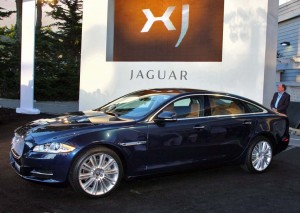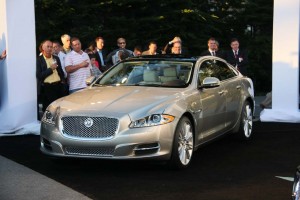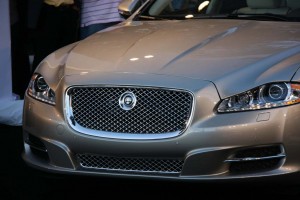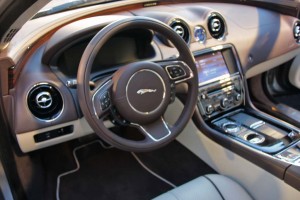
No more playing it safe. After 40 years, the British maker is betting it's time for an all-new look for the 2010 Jaguar XJ sedan.
Sometimes you just have to start all over again.
That’s a lesson Jaguar learned after the launch of its “all-new” XJ sedan, for 2004. The flagship saloon car boasted plenty of positive attributes, including a lightweight aluminum chassis, but visually, it looked almost identical to the model it replaced – and fell flat in the competitive premium luxury segment.
The British marque isn’t making that mistake again, not with the upcoming launch of the 2010 Jaguar XJ, which you’re seeing here for the first time. The new car is more than a flagship for Jaguar, it is an industry icon that could determine the success of a brand that has gone through some radical changes in recent years.

The 2010 Jaguar XF uses lightweight aluminum and magnesium for its body and chassis, trimming 100s of pans compared to competitive offerings.
“Today’s challenging economy raises the stakes for luxury marques bringing new products to market,” acknowledges Richard Beattie, the executive in charge of sales and marketing for Jaguar North America. “Not every new automobile will win the hearts and minds of luxury car buyers.”
That’s what Jaguar discovered in 2004, when it decided to play it safe and essentially recycle the tried-and-true styling of the XJ, which had gone largely unchanged since the first car to bear that badge debuted in 1968. Not so with the 2010.
The new model has a decidedly more coupe-like shape, especially with the flowing roof line. The elongated teardrop-shaped windows are the most striking feature, in silhouette. The nose, if it brings anything to mind, shares some of the basic design DNA of the smaller Jaguar XF, a sporty, blunted snout with a chrome mesh grille on the supercharged version of the new XJ. From the rear, the LED taillights, highlighted by three vertical red stripes, flow into the rear fenders.

The nose of the 2010 Jaguar XJ bears a familial resemblance to models like the XF.
“Sultry,” and “sculpted” are two words you hear in a conversation with Jaguar’s Managing Director Mike O’Driscoll. He’s also quick to point out the virtually all-glass Panoramic roof.
On a more practical line of conversation, the executive notes that there will be both a short and long-wheelbase version of the 4-door, the latter delivering an additional 5 inches of rear legroom. There’s 15.2 cubic feet of trunk space.
Under that sculpted skin, the 2010 Jaguar XJ features an aluminum and magnesium chassis, making the overall car about 300 to 400 pounds lighter than more conventional entries into the premium luxury segment. There are several benefits, including better mileage, reduce emissions, and improved performance.

The new 2010 Jaguar XJ features a 12-inch Virtual Instruments hi-def display, rather than conventional gauges, along with an 8-inch touch screen display for systems like climate control, audio and navigation.
All three versions of the new sedan feature a 5.0-liter V-8. In the “base” car, it is naturally aspirated, and makes 385 horsepower and 380 pound-feet of torque. A mid-level version bolts on a supercharger and brings the output up to 470 hp and 424 lb-ft. They top-line Supersport, also supercharged, gives chase to some of the most powerful competitors in the segment, turning out 510 hp and 461 lb-ft.
Like just about every new, high-line offering, Jaguar has put a premium on electronics, whether for performance, safety or infotainment applications.
On the safety side, there are the usual assortment of chassis and brake systems, like ABS and Stability Control, along with Active Cruise Control.
To enhance performance, the 2010 Jaguar XJ gets Adaptive Dynamics – or variable suspension damping – Active Differential Control (on the supercharged models) and Sequential Shift, with steering wheel-mounted paddle shifters.
There’s a bit – just a bit – of Jaguar tradition to the wood and leather-infused cabin, with its chrome and piano black accents, which seems to center around a classic analog clock mounted dead center on the instrument panel. But there, all resemblance to Jaguars past comes to a quick end.
Rather than traditional gauges, there’s a 12.3-inch High-Definition Virtual Instruments display that provides an adaptable alternative to traditional analog instrumentation. It is complimented by an 8-inch touch screen display that handles tasks such as audio and video, navigation and climate control.
For those looking for a premium audio experience, Jaguar is offering the optional, 1200-watt Bowers and Wilkins system, which features 20 speakers.
Connectivity is increasingly important to car buyers, especially at the high end of the market. The 2010 Jaguar XJ comes standard with a CD/DVD player, HD radio, and SIRIUS Satellite Radio. The new Media Hub provides flexible connectivity through two USB ports, Bluetooth audio streaming or an auxiliary input, which can link to an iPhone, Blackberry or a laptop computer.
The new 2010 Jaguar XJ will reach dealers in early 2010, with prices running from $72,500 to $115,000 for the top-line Supersport.
The automaker could certainly use a boost from the new car. Jaguar was sold off by its long-time parent, Ford Motor Co., recently, and acquired by the ambitious Indian automaker, Tata Motors, along with British sibling Land Rover. The slowdown in the Indian auto market, and the global downturn in luxury sales, have hit parent and subsidiary brands hard.
But so has the competition. Earlier this month, Mercedes-Benz announced an unexpected $5,000 cut in the price of its all-new 2010 E-Class. Jaguar has had to cut into already strained budgets to try to remain competitive.
Not all has gone bad for the company. In a striking victory, it nudged past the perennial industry quality leader, Lexus, in J.D. Power’s latest Vehicle Dependability Survey. O’Driscoll says he’s hoping that will surprise potential customers, many of whom still recall the bad old days of British quality.
But if past is prologue, the striking looks of the new 2010 Jaguar XJ will be the real reason premium luxury buyers come calling.
